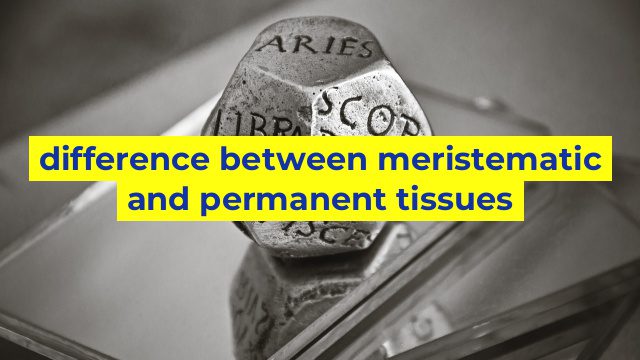Distinguishing Meristematic and Permanent Tissues: What You Need to Know
What are Meristematic Tissues?
Meristematic tissues are undifferentiated plant tissues composed of actively dividing cells. These tissues are responsible for the growth and development of the plant body. Meristematic tissues are located at the growing tips of the roots, stems, and leaves. In these tissues, cells undergo rapid cell division and produce new cells, thus contributing to the production of new plant tissues.
There are two types of meristematic tissues:
1. Apical meristems: Found at the growing tips of the roots and shoots, and responsible for elongating these structures.
2. Lateral (or cambial) meristems: Located in the cambium layer of stems and roots, which is responsible for the growth in thickness of the plant body.
Meristematic tissues have a high rate of cell division and are capable of differentiating into any type of plant cell, making them important in plant regeneration after injury or pruning.
What are Permanent Tissues?
Permanent tissues are mature plant tissues that have differentiated from meristematic tissues and are no longer capable of dividing. They make up the majority of the plant body and carry out specialized functions such as transport and support.
There are two types of permanent tissues:
1. Simple tissues: Consist of only one type of cell and includes parenchyma, collenchyma, and sclerenchyma tissues.
2. Complex tissues: Consist of more than one type of cell and includes xylem and phloem tissues.
Parenchyma tissue is responsible for carrying out primary metabolic functions such as photosynthesis and storage of food. Collenchyma tissue provides mechanical support to young growing parts of the plant, while sclerenchyma tissue provides structural support to mature plant parts.
Xylem and phloem tissues are responsible for transport within the plant body, with the former conducting water and minerals and the latter conducting food molecules to different parts of the plant.
Conclusion
In conclusion, meristematic tissues are responsible for the growth and development of the plant body, while permanent tissues carry out specialized functions such as transport and support. Understanding the difference between these two types of tissues is important in determining the response of plants to environmental conditions, and in regulating plant growth and development.
Table difference between meristematic and permanent tissues
| Meristematic Tissues | Permanent Tissues |
|---|---|
| Manitain its growith throughout its life | Lose their ability to divide and differentiate after a certain time |
| Undifferentiated cells | Differentiated cells |
| Present in growing regions of plants | Present in mature regions of plants |
| Responsible for primary growth | Responsible for secondary growth |
| Provide cells for formation of new organs and tissues | Does not provide cells for formation of new organs and tissues |
| Found in the apical meristem, lateral meristem, and intercalary meristem | Found in the cortex, epidermis, collenchyma, sclerenchyma, and vascular bundles |
